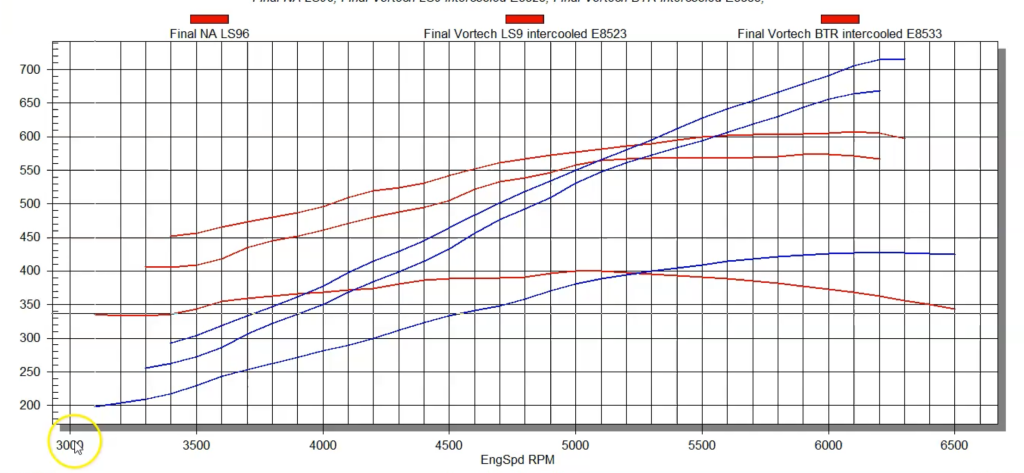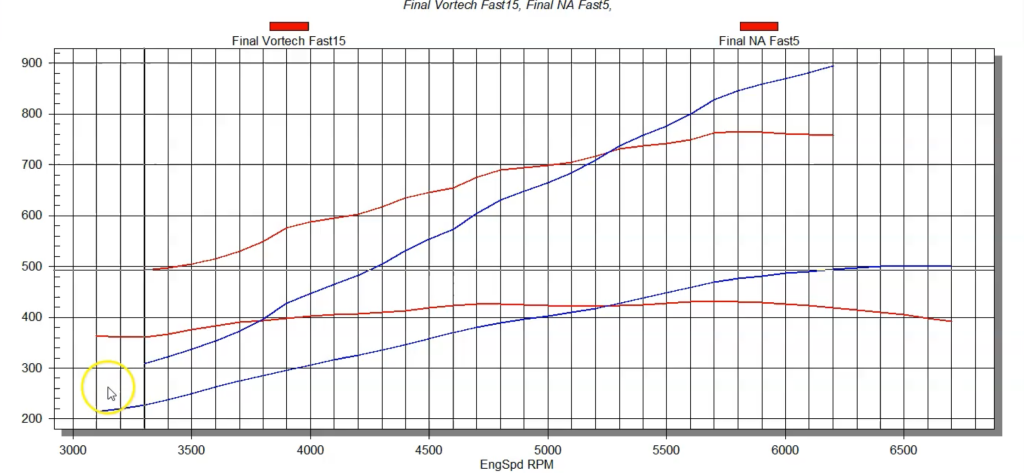This might upset some LS specialists, but when it comes to blower cams, look no further than what the cam does in naturally aspirated trim. To put this theory to the test, we ran a modified 5.3L from Strictly Performance with a couple of different cam profiles.

The Supercharged Camshaft Test Engine
The Strictly Performance 5.3L test motor featured a stock iron block stuffed with a factory crank, Gen. 4 rods, and hard-anodized (factory flat-top) pistons.
To start the test, the short block was equipped with a factory LS9 cam designed for a positive-displacement roots blower, though as testing has shown, it works the same NA, turbo or with (in our case) a Vortech centrifugal supercharger. The boost just multiplies the power curve offered by the cam in NA trim.
The LS9-cammed short block was topped off with a set of Katech-ported 862 heads (part of the boost-ready 5.3L from Strictly Performance), and an early truck intake and throttle body. The 862 heads received a set of BTR dual springs to work with our cam upgrades.
The spring upgrade was teamed with a set of stock rockers (no trunnion upgrade) and hardened pushrods from Comp Cams. Naturally the combination was also sporting other stock components, including the factory truck damper and oil pan. Both the NA and supercharged combos were run with the Holley HP management system controlling a set of 80 pound Accel fuel injectors.
The Blower Cam Test Begins
First on this to-do list was to run the LS9-cammed combo in naturally aspirated trim. Run on the dyno, the 5.3L produced 428 hp at 6,200 rpm and 400 lb.-ft. of torque at 5,000 rpm.
Having run the 5.3L in naturally aspirated trim, we then installed an S-trim Vortech supercharger. Equipped with the stock truck damper and 3.33 inch blower pulley, this combo netted a peak boost of 8.5 psi (at 6,200 rpm). The boost was run through an air-to-water intercooler from ProCharger, that knocked a solid 90 degrees off the IATs. Run with E85 and 22 degrees of timing at the horsepower peak, the supercharged combo produced 669 hp and 574 lb.-ft. of torque.
The Vortech blower improved the power output by a solid 241 hp, but we were just getting started.
After running the blower with the LS9 cam, we swapped out the factory stick in favor of a more powerful cam profile from Brian Tooley Racing. The BTR cam offered a 0.613/0.596 lift split, a 227/244 degree duration split, and 115 degree LSA. Run on the dyno with the same A/F and timing as the LS9 cam, the power output jumped to 716 hp and 607 lb.-ft. of torque. The BTR cam upgrade improved the power output of the supercharged 5.3L by a solid 47 hp.
Every bit as important, the BTR cam improved the power output through the entire (tested) rpm range, with torque gains as high as 48 lb.-ft. near 3,500 rpm!

More Upgrades & A Stage 4 Cam
As a further testament to the role of the camshaft on boosted motors, we ran a second test on the Strictly Performance 5.3L, but also stepped up to even wilder cam timing. We combined the wilder cam timing with other mods that significantly improved the power output of the naturally aspirated combination, then stepped things up even further with the installation of a more powerful Vortech supercharger.
The cam timing upgrade included the installation of a Summit Racing Stage 4 cam that offered a 0.625/0.605 lift split, a 234/247 degree duration split, and 113 +3.5 LSA. Based on specs alone, the cam was significantly bigger than either the factory LS9 cam or the BTR Stage 2 blower cam. The wilder cam timing would add power all on its own, but the effect on the blower motor was even more pronounced—but not because the cam was specifically designed as a centrifugal blower cam.
The wilder cam timing naturally pushed peak power further up in the rpm range, which is of great potential benefit to a centrifugal blower combo, since the flow and boost pressure offered by the centrifugal blower increase with engine speed. Simply running the blower motor higher in the rev range can net sizable power gains, especially when teamed with cam timing that already enhanced the power out in that range. The Summit Racing Stage 4 Cam achieved both.
Along the same lines, we also upgraded the intake manifold on the 5.3L, stepping up from the early truck intake run previously to a FAST LSXR intake. In previous testing, the FAST has consistently shown its superiority to the truck intake. The gains offered by the intake swap were greatest beyond 4,500 rpm, or right where they will be put to greatest use with the Vortech blower. The cam and intake upgrade were further enhanced with the installation of a larger Vortech T-trim supercharger.
Capable of supporting near 1,000 horsepower, we were just scratching the surface of what this blower was capable of.
The Final Dyno Results
The final piece of the performance puzzle was the installation of an ATI Super Damper and smaller blower pulley to crank up the speed of the T trim. As with the previous test, boost supplied by the Vortech was run through the air-to-water intercooler (using dyno water).
This combination netted a peak boost pressure of 13.8 psi (up from 8.5 psi) to our now 502 hp NA combination (up from 428 hp). The result was nearly 900 hp (895 at 6,200 rpm), with belt slippage being the only thing that kept this combo from exceeding the 900 hp mark on E85. Peak torque checked in at 766 lb.-ft. (up from 607 lb.-ft.). Judging by the shape of the boost/power curves, and the fact that the NA combo made peak power at 6,700 rpm, we suspect easy mid-900 horsepower numbers with cog pulleys to eliminate the belt slippage.
Good blower motors start out as good NA motors!



















Amazing series of events of progress. Very entertaining to read and thank you for providing ample amounts of detail and nerd stats. I will be buying a new LS or LT crate motor and transmission to put in my 2008 lexus is250. Hope it goes as smoothly as it seemed to have went for you guys.